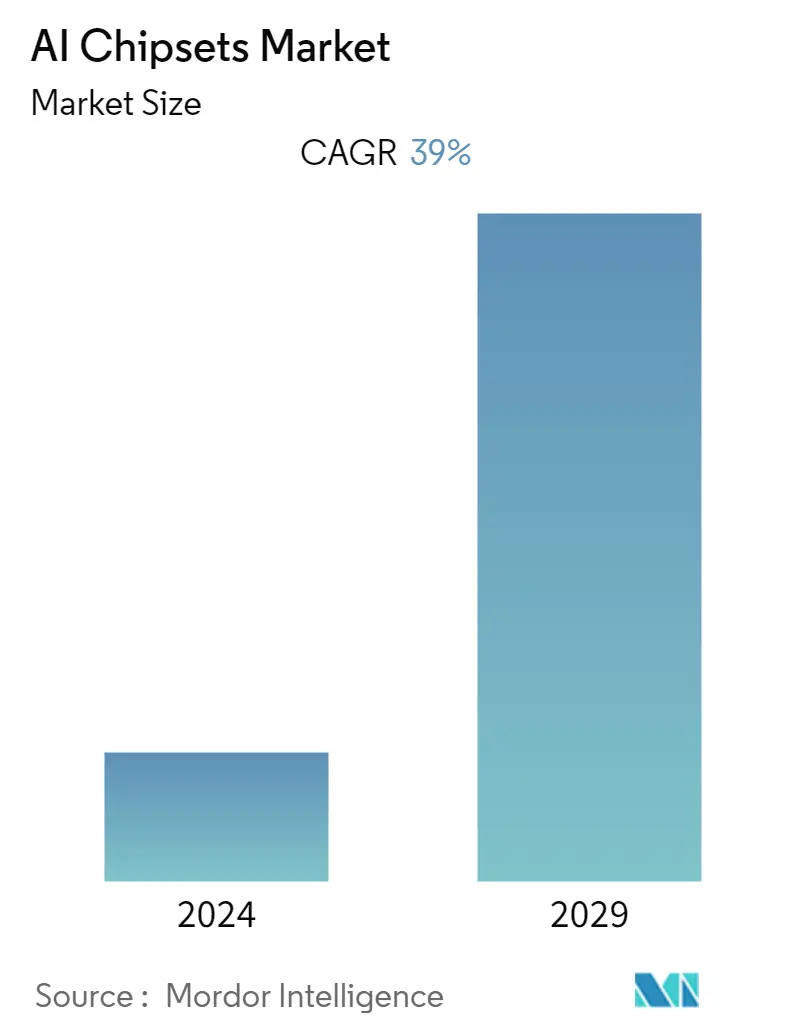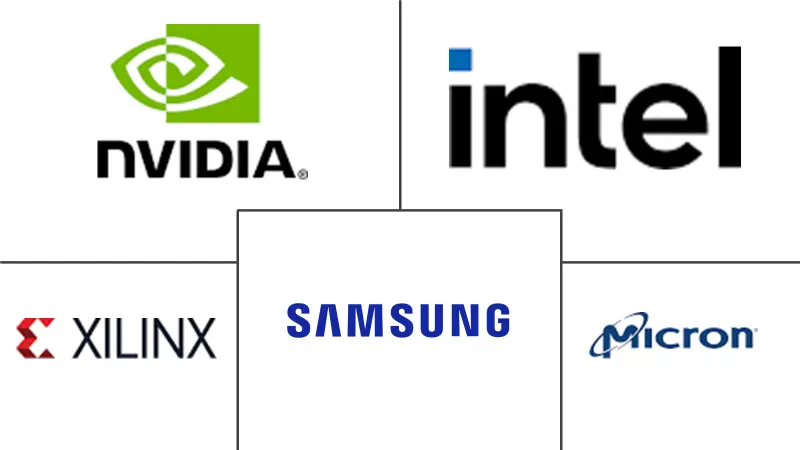Market Size of AI Chipsets Industry

| Study Period | 2019 - 2029 |
| Base Year For Estimation | 2023 |
| CAGR | 39.00 % |
| Fastest Growing Market | Asia-Pacific |
| Largest Market | North America |
| Market Concentration | Medium |
Major Players
*Disclaimer: Major Players sorted in no particular order |
AI Chipsets Market Analysis
The AI chipsets market is anticipated to register a CAGR of 39% during the forecast period. Various factors, such as a rise in demand for edge analytics, autonomous driving, and smart appliances in the consumer electronics industry, are anticipated to support the market growth.
- The rapidly growing demand for machine learning in multiple sectors, such as automotive, finance, and retail, boosts the adoption of AI technology. The most famous application of AI chipsets in the automotive industry includes manufacturing a driverless car to achieve the L5 level of autonomous technology.
- Artificial intelligence (AI) is entering nearly every aspect of consumer electronics. Its uses are growing beyond cell phones to include the automotive industry. This growth is bringing a slew of new prospects to the semiconductor industry. The requirement to process a constantly rising volume of data is a major element influencing the AI chipset market's growth.
- Moreover, as AI enables machines to perform various activities like those operated by human beings, numerous opportunities are expected to open in the future. Additionally, the growing focus on developing human-aware AI systems is boosting the growth of the market. However, the lack of a skilled workforce and the absence of standards and protocols are restraining the market growth.
- The need for a large number of ASICs is anticipated to rise as artificial intelligence gains more ground in global technology. Companies, such as Amazon and Google, are already in the process of fortifying their server silicon endeavors.
- Companies are using new technologies, such as artificial intelligence, to design new AI chips. For instance, as per a paper published in the journal Nature in June 2021, Google is using AI and machine learning to help design its next generation of AI chips. According to the company, work that takes months for humans can be completed by AI in under six hours.
- Furthermore, the increasing neuromorphic research is an emerging field within the areas of AI hardware anticipated to boost the demand for AI chips. The intuition here is to develop techniques inspired by the real neurons in the brain function; hence, the name neuromorphic was used. The low energy and high-quality output of neurons have enthused researchers to develop Spiking Neural Networks (SNNs). However, these SNNs require hardware of their own.
- The outbreak of COVID-19 has negatively impacted the AI chipsets market's supply chain and production. The impact on semiconductor producers was severe. The acceptance of AI for improving consumer services and reducing operational costs, the expanding number of AI applications, improving processing power, and the growing adoption of deep learning and neural networks are major market drivers. Many companies in the semiconductor supply chain worldwide restricted or even stopped operations due to workforce constraints, causing a bottleneck for semiconductor-dependent end-product companies.
AI Chipsets Industry Segmentation
An AI chip is an integrated circuit dedicated to training and executing neural networks, the architecture of AI software. The most commercial artificial neural network (ANN) applications are deep learning. The report comprises market segmentation by component, including Central Processing Unit (CPU), Graphics Processing Unit (GPU), Neural Network Processor (NNP), and other components pertaining to various end-user segments like consumer electronics, automotive, healthcare, automation & Robotics, and other Applications. The study offers competitive intelligence of key vendors operating in the market and their financials, strategies, SWOT, and recent developments. The study also offers a brief analysis of the impact of COVID-19 on the market studied.
| By Component | |
| Central Processing Unit (CPU) | |
| Graphics Processing Unit (GPU) | |
| Neural Network Processor (NNP) | |
| Other Components |
| By Application | |
| Consumer Electronics | |
| Automotive | |
| Healthcare | |
| Automation and Robotics | |
| Other Applications |
| By Geography | |
| North America | |
| Europe | |
| Asia-Pacific | |
| Latin America | |
| Middle-East |
AI Chipsets Market Size Summary
The AI chipsets market is poised for significant growth, driven by the increasing demand for advanced technologies such as edge analytics, autonomous driving, and smart appliances within the consumer electronics sector. The integration of artificial intelligence across various industries, including automotive, finance, and retail, is propelling the adoption of AI chipsets. This trend is particularly evident in the automotive industry, where AI chipsets are crucial for developing fully autonomous vehicles. The semiconductor industry is experiencing new opportunities as AI technology becomes integral to processing vast amounts of data. However, challenges such as a shortage of skilled labor and the lack of standardized protocols are hindering market expansion. The demand for application-specific integrated circuits (ASICs) is expected to rise, with major companies like Amazon and Google enhancing their server silicon capabilities. Innovations in AI chip design, such as those by Google using AI and machine learning, are further shaping the market landscape.
The Asia-Pacific region is anticipated to witness substantial growth in the AI chipsets market, fueled by emerging economies like China, India, and South Korea. The region's high adoption of AI chipsets in consumer electronics, driven by the integration of voice commands and enhanced user experiences, is a key factor in this growth. Japan's proactive AI policies and the presence of leading smartphone and semiconductor manufacturers in the region contribute to the market's expansion. Despite the challenges posed by the COVID-19 pandemic, which disrupted supply chains and increased demand for consumer electronics, the market is expected to recover and thrive. Prominent industry players, including Intel, Samsung, NVIDIA, and Micron Technology, are engaged in strategic initiatives to strengthen their market positions through collaborations, product innovations, and expansions. The market remains moderately consolidated, with ongoing advancements in AI chip technology and applications driving its development.
AI Chipsets Market Size - Table of Contents
-
1. MARKET INSIGHTS
-
1.1 Market Overview
-
1.2 Industry Attractiveness - Porter's Five Forces Analysis
-
1.2.1 Threat of New Entrants
-
1.2.2 Bargaining Power of Buyers
-
1.2.3 Bargaining Power of Suppliers
-
1.2.4 Threat of Substitute Products
-
1.2.5 Intensity of Competitive Rivalry
-
-
1.3 Industry Value Chain Analysis
-
1.4 Assessment of the Impact of COVID-19 on the AI Chipsets Market
-
-
2. MARKET SEGMENTATION
-
2.1 By Component
-
2.1.1 Central Processing Unit (CPU)
-
2.1.2 Graphics Processing Unit (GPU)
-
2.1.3 Neural Network Processor (NNP)
-
2.1.4 Other Components
-
-
2.2 By Application
-
2.2.1 Consumer Electronics
-
2.2.2 Automotive
-
2.2.3 Healthcare
-
2.2.4 Automation and Robotics
-
2.2.5 Other Applications
-
-
2.3 By Geography
-
2.3.1 North America
-
2.3.2 Europe
-
2.3.3 Asia-Pacific
-
2.3.4 Latin America
-
2.3.5 Middle-East
-
-
AI Chipsets Market Size FAQs
What is the current AI Chipsets Market size?
The AI Chipsets Market is projected to register a CAGR of 39% during the forecast period (2024-2029)
Who are the key players in AI Chipsets Market?
Samsung Electronics, NVIDIA Corp., Xilinx Inc., Micron Technology Inc. and Intel Corporation are the major companies operating in the AI Chipsets Market.

